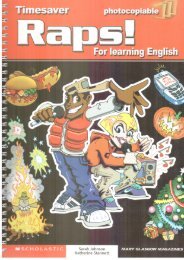English_Book_2-Teacher_300913
English_Book_2-Teacher_300913
English_Book_2-Teacher_300913
Create successful ePaper yourself
Turn your PDF publications into a flip-book with our unique Google optimized e-Paper software.
INTRODUCTION➤ Fun with songsThe Fun with songs section is found at the end ofthe Student <strong>Book</strong>. These song projects provide anopportunity for students to take a break and relax,listen to and discuss music and musicians, and gaina greater appreciation and understanding of <strong>English</strong>songs.➤ Focus on cultureFocus on culture pages are found at the end of theStudent <strong>Book</strong>. These readings allow students to gaincross-cultural understanding through the study ofother cultures and comparisons with their own. EachFocus on culture spread includes discussion andwriting practice.Special Features in the <strong>Teacher</strong>’s Edition➤ Background notesBackground notes in this <strong>Teacher</strong>’s Edition presentin-depth information on U.S. and world culture astouched on in the dialogues, exercises, and readingspresented in the Student <strong>Book</strong>. Relevant informationfrom the notes can be shared with students toincrease their cross-cultural understanding.➤ Focus on multiple intelligencesRecognizing that students have a variety of learningstyles and abilities, teaching suggestions in this<strong>Teacher</strong>’s Edition include notes on activities witha strong focus on multiple intelligences. Theseactivities will benefit students with natural affinitiesto specific intelligences and related learning styles.At the same time, focusing on different intelligencescan help all students explore and further developa wider range of learning modes. The intelligenceshighlighted in the teaching notes are:Kinesthetic: Students with a strong kinesthetic, orbodily, intelligence will learn well when engagingin activities involving motor skills. Activities suchas hands-on projects, games, total physical responseexercises (TPR), and the acting out of dialoguesand scripts with movement and gestures stimulatekinesthetic intelligence.Visual: A student with visual/spacial intelligenceresponds to visual representations and is good atcreating mental images. Making or using pictures,diagrams, graphic organizers, maps, symbols,photos or videos, etc., will be helpful for this type oflearner, as will activities involving visualizing.Auditory: A student with strong auditory/musicalintelligence is sensitive to sounds and patterns ofrhythm, intonation, and pitch. Students with thistype of intelligence will be stimulated by activitiesinvolving sound—pronunciation and intonationwork, listening exercises, songs, jazz chants, etc.Logical: A student with developed logical/mathematical intelligence is good at thinkinglogically, recognizing patterns, and doingxivcalculations. A logical learner will benefit fromactivities involving deductive and inductivethinking, classification, rules, and processes.Linguistic: Students with a high degree of linguisticintelligence are talented at extracting meaning fromtext and using language to express meaning. Theytend to be good at learning languages and generallyhave an affinity for writing, reading, summarizing,giving speeches, and other language-based activities.Interpersonal: Students with a high degree ofinterpersonal intelligence have a developedsensitivity to others and learn well through socialinteractions. Pair and group work, collaborativelearning, interviewing, writing dialogues, andreflecting on social situations presented in dialoguesare examples of activities helpful to an interpersonallearner.Intrapersonal: A student who is self-reflectiveand sensitive to his or her own feelings tends tohave a high degree of intrapersonal intelligence.Independent work, self-assessment, self-reflection,personalizing, journal-writing, and thinking aboutone’s personal reaction to situations and topics willbe of benefit to the intrapersonal learner.➤ Focus on valuesAs the classroom is one of the best places to helpyoung people develop values and character, eachunit of the <strong>Teacher</strong>’s Edition includes notes focusingon values. The characters and situations presentedin the dialogues and photostories are modeled afterreal teens and thus present numerous opportunitiesfor reflection on appropriate and inappropriatebehavior. Focus on values notes provide suggestionson how to help students recognize and react toimplicit and explicit values, attitudes, and behaviorin dialogues and photostories.➤ Cross-curricular activitiesThe <strong>Teacher</strong>’s Edition includes Cross-curricularactivity suggestions for each unit of the Student<strong>Book</strong>. These activities encourage students touse—and sometimes expand—their knowledge ofsocial studies, science, literature, and the arts whilepracticing <strong>English</strong>.➤ Home/School connectionParents play a fundamental role in the educationof their children. The more they get involved andencourage their children, the better results studentsachieve. For this reason the <strong>Teacher</strong>’s Editionprovides Home/School connection suggestionson increasing parental involvement in students’<strong>English</strong> education.➤ Grammar referenceThe Grammar reference section found at the end ofthe <strong>Teacher</strong>’s Edition provides in-depth grammaticalbackground about the structures and elements inPostcards_splitB_TE1_FM.indd xiv2/27/07 10:23:15 AMPostcards




